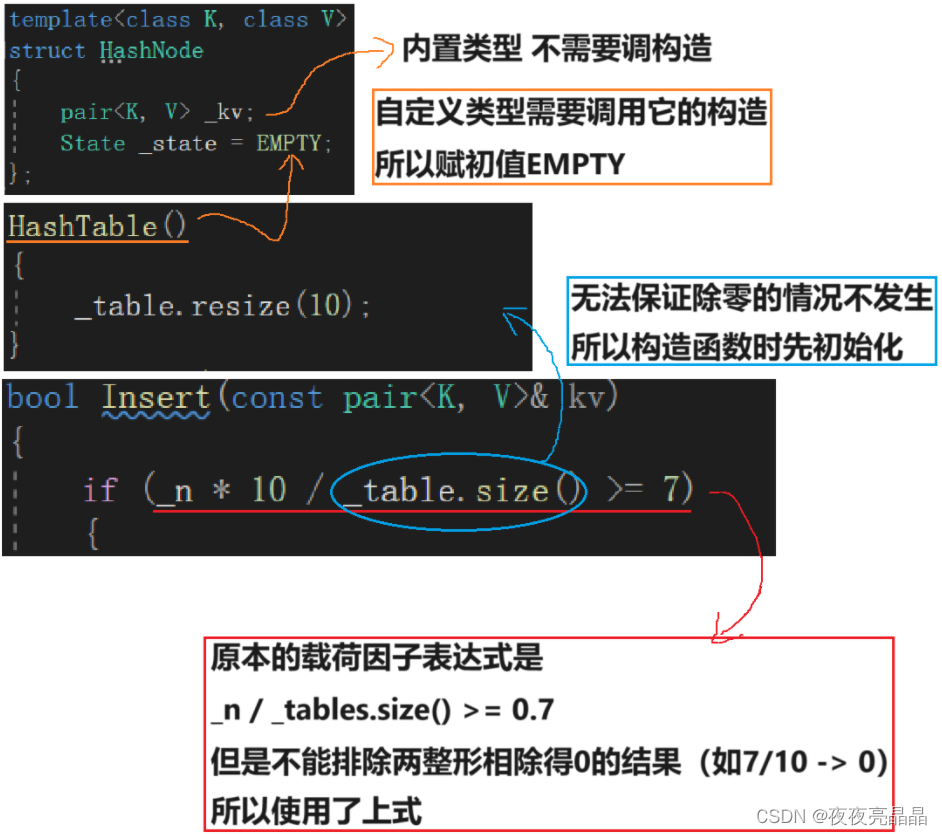目录
一、引言
之前或多或少遇到过用数组模拟哈希表的写法,也见到过不使用比较大小排序的方法,这都是间接借助哈希表来实现的。但是有一个问题,当数据过于分散时,应该怎么使用表进行统计?
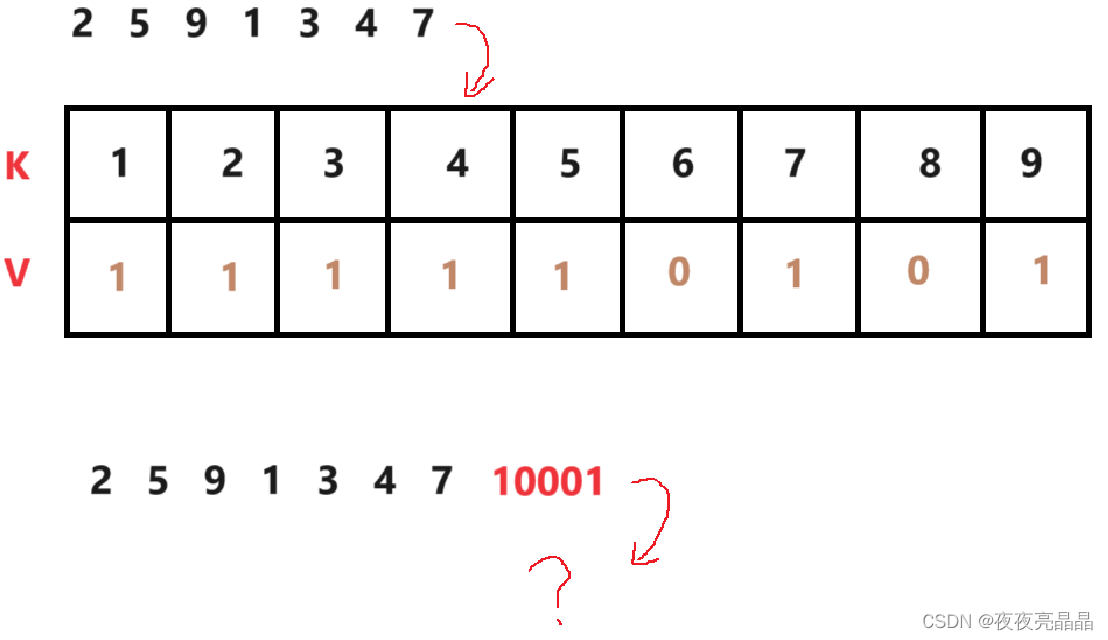
二、哈希表的构成
2.1 数据分散时的处理
当数据过于分散时,会采用取模的办法,使数据精简,一般是使用 键值Key % 当前容量 来存储。
此时又会引入一个新的问题,取模时数据如果重复怎么办,比如 1 和 10001 ,都要存储在当前容量为 10 的哈希表中,应该怎么办呢?
此时的办法时,按照插入的顺序,先来者居上,这里 10001 的位置被 1 顶掉了,所以它要朝后去,那键值为 2 的地方被 10001 挤掉了,后来插入的 2 只能继续挤后面的位置:
2.2 节点的定义
从这里就可以看出,每一个位置都要去标记一下是否已经存在值,若没有,对应的元素可以落座;若有,那么该元素只能向后走,这里使用枚举来记录节点状态:
enum State
{
EXIST,
EMPTY,
DELETE
};
毕竟数据结构还是哈希表,每个节点就必要存储一个 KV 模型,下面就是节点的定义:
template<class K, class V>
struct HashNode
{
pair<K, V> _kv;
State _state = EMPTY;
};2.3 HashTable的定义
定义好了单个节点,下面就要来看一下整个表是怎么存储节点的,其实哈希表使用什么数据结构都可以存储它的节点,单个节点的定义一旦明确了,节点之间的连接方式相较之下就自由多了,这里使用数组 vector 进行存储。此外,根据上面的描述,应该可以认识到,哈希表不一定是满的,因为后续扩容的需要,这里还要记录一下哈希表当前的有效数据个数:
template<class K, class V>
class HashTable
{
private:
vector<HashNode<K, V>> _table;
size_t _n
}
三、Insert 函数
3.1 插入的逻辑
首先,就是对于数据的精简,上面已经说了,可以使用Key的值模上HashTable的大小:
size_t index = kv.first % _table.size();其次,就是要确认一下哈希表该节点的状态,若为 EXIT ,那么就需要继续向哈希表的后面查找,直到某一节点为 EMPTY 。
此外,还有一特殊情况,那就是若从哈希表的某点开始向后查找,有可能查找到哈希表的结尾,此时就需要再从哈希表头开始查找,这时应该怎么办呢?那就是让索引模上哈希表的size。
size_t index = kv.first % _table.size();
while (_table[index]._state == EXIST)
{
index++;
index %= _table.size();
}当这个 while 循环结束后,说明终于找到了空节点,此时可以进行插入,但别忘了有效数据要进行自增:
size_t index = kv.first % _table.size();
while (_table[index]._state == EXIST)
{
index++;
index %= _table.size();
}
_table[index]._kv = kv;
_table[index]._state = EXIST;
_n++;3.2 扩容
当然,当整个表满了之后,要对表进行扩容。
但是当表还没满时,插入的效率就已经大大缩减,因为表快满了时,每个数的插入基本都要对哈希表进行遍历,这样就发挥不出它应有的优势,使用这里引入载荷因子的概念。
何时进行扩容
哈希表的扩容通常依赖于一个关键参数——载荷因子(Load Factor)。载荷因子是当前存储在哈希表中的元素数量与哈希表总容量的比例,公式为:

当载荷因子超过某个阈值(如 0.75)时,就可能进行扩容。这个阈值是一个平衡空间效率和时间效率的折中选择。载荷因子越高,表中的冲突可能越多,从而影响查找和插入操作的效率;载荷因子过低,则可能导致空间的浪费。
下面使用图来解释一下上面如何进行扩容,这里以载荷因子为 0.7 举例:
如何进行扩容
哈希表扩容通常涉及以下几个步骤:
- 创建更大的哈希表:通常新的哈希表大小是原来的两倍。
- 重新计算哈希:因为哈希表的大小改变了,大部分元素的哈希值相对于新表的大小也会改变。因此,需要重新计算每个元素的哈希值,并将它们插入到新的哈希表中。
- 迁移数据:将原哈希表中的所有元素按照新的哈希值重新插入到新表中。这一步是成本最高的,因为它涉及到遍历旧表中的所有元素并重新插入。
- 释放旧表空间:一旦旧表中的所有元素都迁移到新表中,旧表的空间可以被释放。
下面使用图来解释一下上面如何进行扩容,这里以载荷因子为 0.7 举例:
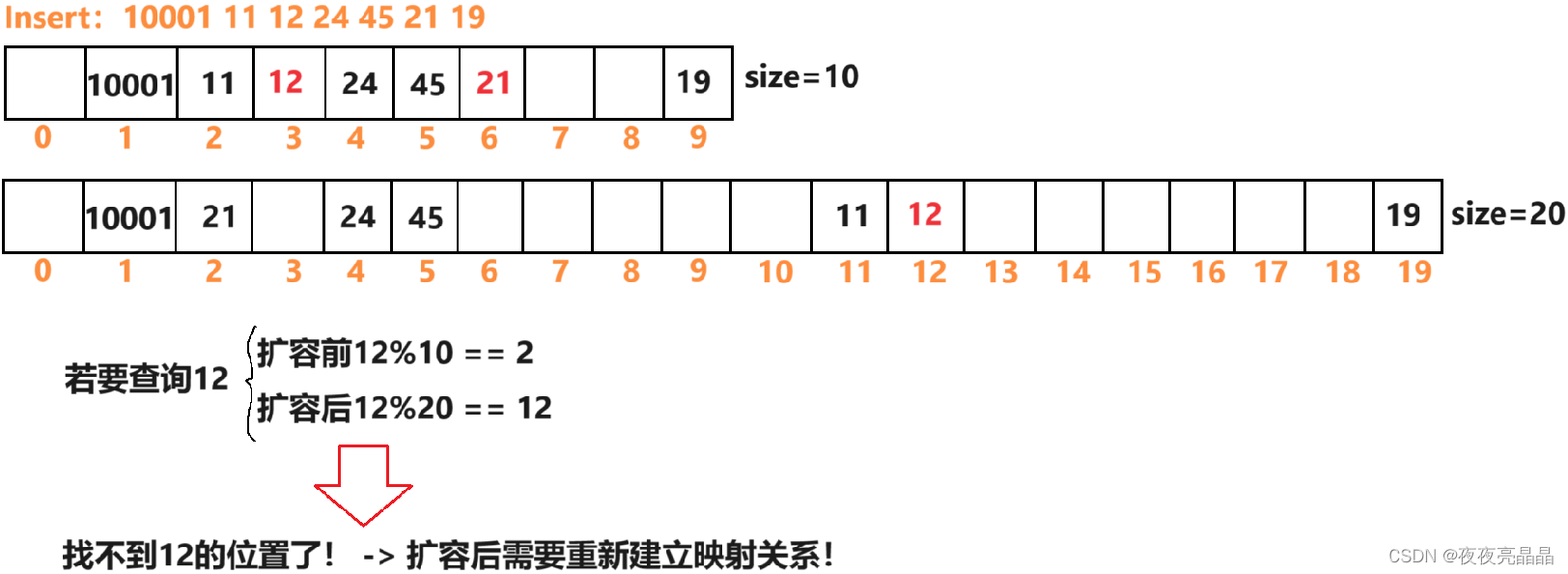
通过上图的解释,就可以得到结论:扩容后,所有数据都需要重新建立映射关系,这也是成本最高的一步!这里使用新的HashTable,并直接借用它的Insert。注意:不可以直接在原HashTable中进行扩容和数据的重新插入,这样可能会导致原来的数据被覆盖!
if (_n * 10 / _table.size() >= 7)
{
HashTable<K, V> newHT;
newHT._table.resize(_table.size() * 2);
for (size_t i = 0; i < _table.size(); i++)
{
if (_table[i]._state == EXIST)
newHT.Insert(_table[i]._kv);
}
_table.swap(newHT._table);
}3.3 插入函数代码
bool Insert(const pair<K, V>& kv)
{
if (_n * 10 / _table.size() >= 7)
{
HashTable<K, V> newHT;
newHT._table.resize(_table.size() * 2);
for (size_t i = 0; i < _table.size(); i++)
{
if (_table[i]._state == EXIST)
newHT.Insert(_table[i]._kv);
}
_table.swap(newHT._table);
}
size_t index = kv.first % _table.size();
while (_table[index]._state == EXIST)
{
index++;
index %= _table.size();
}
_table[index]._kv = kv;
_table[index]._state = EXIST;
_n++;
return true;
}四、Find 函数
Find 函数也是根据 Key 的值进行的,所以这和 Insert 函数查找空节点时的逻辑一样,可以追踪哈希表各个节点的状态,如果该节点非空,再根据哈希表的键值与要查找键值的比对来确认查找节点的地址。另外,使用节点的地址作为函数的返回值,也是为了后面使用 Erase 函数的方便:
HashNode<K, V>* Find(const K& Key)
{
size_t index = Key % _table.size();
while (_table[index]._state != EMPTY)
{
if (_table[index]._state == EXIST
&& _table[index]._kv.first == Key)
{
return &_table[index];
}
index++;
index %= _table.size();
}
return nullptr;
}五、Erase 函数
使用 Erase 函数,也是从更改哈希表节点的状态下手,只需要更改节点的状态,不需要实现 Value 的覆盖即可完成节点的删除。
bool Erase(const K& Key)
{
HashNode<K, V>* HD = Find(Key);
if (HD == nullptr)
return false;
else
{
HD->_state = DELETE;
_n--;
return true;
}
}六、完成代码
#pragma once
#define _CRT_SECURE_NO_WARNINGS
#include <iostream>
#include<vector>
using namespace std;
enum State
{
EXIST,
EMPTY,
DELETE
};
template<class K, class V>
struct HashNode
{
pair<K, V> _kv;
State _state = EMPTY;
};
template<class K, class V>
class HashTable
{
public:
HashTable()
{
_table.resize(10);
}
bool Insert(const pair<K, V>& kv)
{
if (_n * 10 / _table.size() >= 7)
{
HashTable<K, V> newHT;
newHT._table.resize(_table.size() * 2);
for (size_t i = 0; i < _table.size(); i++)
{
if (_table[i]._state == EXIST)
newHT.Insert(_table[i]._kv);
}
_table.swap(newHT._table);
}
size_t index = kv.first % _table.size();
while (_table[index]._state == EXIST)
{
index++;
index %= _table.size();
}
_table[index]._kv = kv;
_table[index]._state = EXIST;
_n++;
return true;
}
HashNode<K, V>* Find(const K& Key)
{
size_t index = Key % _table.size();
while (_table[index]._state != EMPTY)
{
if (_table[index]._state == EXIST && _table[index]._kv.first == Key)
{
return &_table[index];
}
index++;
index %= _table.size();
}
return nullptr;
}
bool Erase(const K& Key)
{
HashNode<K, V>* HD = Find(Key);
if (HD == nullptr)
return false;
else
{
HD->_state = DELETE;
_n--;
return true;
}
}
private:
vector<HashNode<K, V>> _table;
size_t _n;
};
void TestHT1()
{
int tmp[] = {11, 22, 8, 3, 13, 55};
HashTable<int, int> HT;
for (auto e : tmp)
{
HT.Insert(make_pair(e, e));
}
cout << HT.Find(11) << endl;
cout << HT.Find(22) << endl;
HT.Erase(11);
cout << HT.Find(11) << endl;
cout << HT.Find(22) << endl;
}
void TestHT2()
{
int tmp[] = { 11, 22, 8, 3, 13, 55 };
HashTable<int, int> HT;
for (auto e : tmp)
{
HT.Insert(make_pair(e, e));
}
int tmp2[] = { 0, 2, 4, 6, 8 };
for (auto e : tmp)
{
HT.Insert(make_pair(e, e));
}
}七、Key值为其他时
上面的代码都存在取模的运算,显而易见,只有整型才能进行取模运算,当 Key 值为浮点数或者负数甚至是字符串时,哈希表就不管用了。
7.1 Key 为非字符串
当 Key 为非字符串时,如果是负数、浮点数,都可以对它们进行强制的显式类型转化,可以借助一个仿函数,对负数和浮点数进行优化处理,至于负数如何强转为正数,请看下图: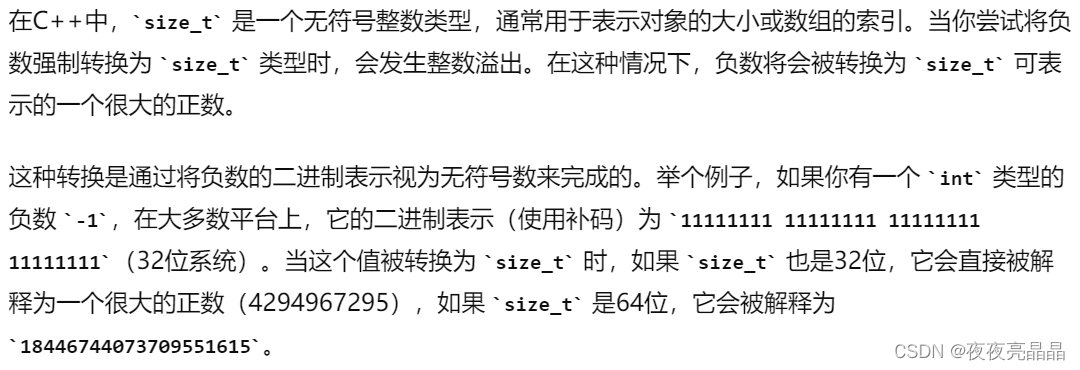
仿函数的写法也很简单:
template<class K>
struct HashFunc
{
size_t operator()(const K& Key)
{
return (size_t)Key;
}
}此时只需要在HashTable的模板参数中加入该模板即可:
template<class K, class V, class Hash = HashFunc<K>>
class HashTable
{
};调用时,使用 Way 实例化一个对象,然后直接使用对象(Key)即可:
Hash hs;
size_t index = hs(kv.first) % _table.size();7.2 Key 为字符串
Key 为字符串时,其实有很多种转换方法,下面介绍的是BKDR算法:
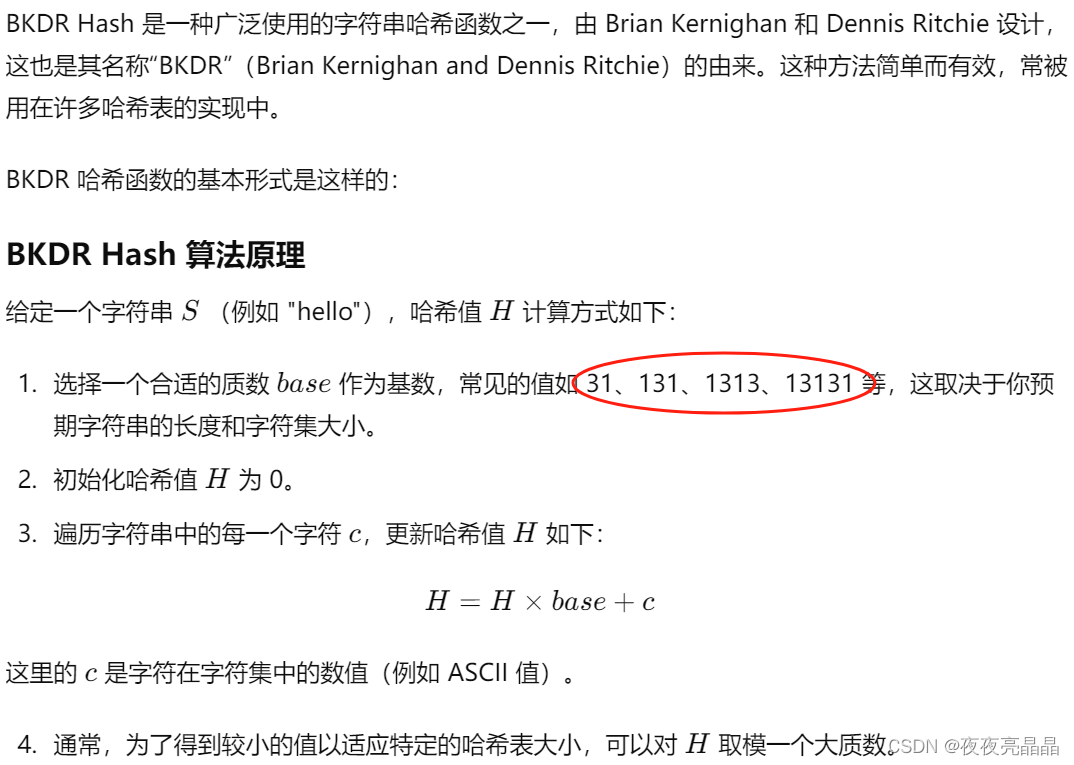
以下是BKDR算法的一个简单实现:
#include <iostream>
#include <string>
unsigned long BKDRHash(const std::string& str)
{
unsigned long hash = 0;
size_t seed = 131; // 31 131 1313 13131等,常见质数基数
for (char c : str)
{
hash = hash * seed + c;
}
return hash;
}
int main()
{
std::string input = "hello";
std::unsigned long hashValue = BKDRHash(input);
std::cout << "The BKDR hash of \"" << input << "\" is " << hashValue << std::endl;
return 0;
}
因为模板只有Key为String和非String这两种情况,完全可以进行模板的特化:
template<>
struct HashFunc<string>
{
size_t operator()(string& Key)
{
size_t hash = 0;
for (auto ch : Key)
{
hash *= 131;
hash += ch;
}
return hash;
}
};7.3 总结
1. 通用模板
对于一般类型 K 的实例:
template<class K>
struct HashFunc
{
size_t operator()(const K& Key)
{
return (size_t)Key;
}
};
这个模板尝试将任何类型 K 的对象直接转换为 size_t 类型。这种方式假定类型 K 可以安全地转换为 size_t,通常适用于基本数据类型如 int、char 等。
2. 特化模板对 std::string
对 std::string 类型进行了特化:
template<>
struct HashFunc<string>
{
size_t operator()(string& Key)
{
size_t hash = 0;
for (auto ch : Key)
{
hash *= 131;
hash += ch;
}
return hash;
}
};
这个特化版本使用了一个简单的哈希算法,通过遍历字符串中的每个字符,将哈希值乘以一个基数(这里使用了131,这是一个常见的质数基数用于哈希函数中),然后加上字符的ASCII值。
通用模板的调用
这个模板旨在处理那些可以直接转换为 size_t 的数据类型,比如基本的数值类型(int, double, char 等)。当你使用这种类型的数据时,模板会尝试将其转换成一个 size_t 值。
示例代码:
HashFunc<int> hashFunc;
int num = 42;
size_t hashValue = hashFunc(num); // 直接调用通用模板
特化模板的调用
针对 std::string 类型的特化版本设计是为了处理那些不能直接转换为 size_t 的复杂数据类型,如字符串。这个特化版本使用了一个自定义的哈希函数来计算字符串的哈希值。
示例代码:
HashFunc<std::string> stringHashFunc;
std::string text = "hello";
size_t stringHash = stringHashFunc(text); // 调用针对 std::string 的特化版本
八、完整代码
可以直接使用Gitee查看只包含整型的代码和兼容型的代码:
#pragma once
#define _CRT_SECURE_NO_WARNINGS
#include <iostream>
#include<vector>
#include<string>
using namespace std;
enum State
{
EXIST,
EMPTY,
DELETE
};
template<class K>
struct HashFunc
{
size_t operator()(const K& Key)
{
return (size_t)Key;
}
};
template<>
struct HashFunc<string>
{
size_t operator()(string& Key)
{
size_t hash = 0;
for (auto ch : Key)
{
hash *= 131;
hash += ch;
}
return hash;
}
};
template<class K, class V>
struct HashNode
{
pair<K, V> _kv;
State _state = EMPTY;
};
template<class K, class V, class Hash = HashFunc<K>>
class HashTable
{
public:
HashTable()
{
_table.resize(10);
}
bool Insert(const pair<K, V>& kv)
{
if (_n * 10 / _table.size() >= 7)
{
HashTable<K, V> newHT;
newHT._table.resize(_table.size() * 2);
for (size_t i = 0; i < _table.size(); i++)
{
if (_table[i]._state == EXIST)
newHT.Insert(_table[i]._kv);
}
_table.swap(newHT._table);
}
Hash hs;
size_t index = hs(kv.first) % _table.size();
while (_table[index]._state == EXIST)
{
index++;
index %= _table.size();
}
_table[index]._kv = kv;
_table[index]._state = EXIST;
_n++;
return true;
}
HashNode<K, V>* Find(const K& Key)
{
Hash hs;
size_t index = hs(Key) % _table.size();
while (_table[index]._state != EMPTY)
{
if (_table[index]._state == EXIST && _table[index]._kv.first == Key)
{
return &_table[index];
}
index++;
index %= _table.size();
}
return nullptr;
}
bool Erase(const K& Key)
{
HashNode<K, V>* HD = Find(Key);
if (HD == nullptr)
return false;
else
{
HD->_state = DELETE;
_n--;
return true;
}
}
private:
vector<HashNode<K, V>> _table;
size_t _n;
};
void TestHT1()
{
int tmp[] = {11.2, -22, 8, 3, 13, 55};
HashTable<int, int> HT;
for (auto e : tmp)
{
HT.Insert(make_pair(e, e));
}
cout << "11.2:" << HT.Find(11.2) << endl;
cout << "-22:" << HT.Find(-22) << endl;
HT.Erase(11.2);
cout << "11.2:" << HT.Find(11.2) << endl;
cout << "-22:" << HT.Find(-22) << endl;
}
void TestHT2()
{
int tmp[] = { 11, 22, 8, 3, 13, 55 };
HashTable<int, int> HT;
for (auto e : tmp)
{
HT.Insert(make_pair(e, e));
}
int tmp2[] = { 0, 2, 4, 6, 8 };
for (auto e : tmp)
{
HT.Insert(make_pair(e, e));
}
}